The Cathedral of Christ, Liverpool: The fascinating story of Britain's largest cathedral
The architect who created the red telephone kiosk and the London power station today occupied by Tate Modern also designed Britain’s largest cathedral. John Goodall looks at the story of this masterpiece.


On June 17, 1901, the diminutive figure of Francis Chavasse, the Anglican Bishop of Liverpool, addressed a packed public meeting in Liverpool Town Hall. Having spoken of the great strides taken across the world by the Church of England in the previous century, with its foundation of 90 new dioceses across the colonies and a further eight ‘at home’ (including Liverpool), he pointed out that, in England, the only examples of post-Reformation cathedrals were St Paul’s in London and Truro, Cornwall.
Liverpool, he urged, was a city that rivalled ‘the great commercial cities of Carthage, Corinth, Tyre and Venice, and of which we might say with perfect truth is far richer than any of them’. There needed to be a cathedral, he argued – between bursts of applause – for three reasons. Such a building would be ‘a visible witness for God in the midst of this great city’, it could accommodate ‘popular and diocesan services’ with large congregations and ‘express and deepen the spiritual longings and aspirations of many among us’.

He went on: ‘We must give to God not that which costs us nothing, but the very best that Liverpool… can afford. We must build for posterity… [like] our forefathers who have handed down to us those great cathedrals which are amongst the greatest heritages of the English nation… I trust that when this cathedral is built it will be built not only by… the rich, but also by the pence of our poor… [who] will be able to look up to it and say “we helped build it”… making them feel… that the Church belongs to them and that they belong to the Church.’
His words were not to prove empty rhetoric. Incredibly, over a period of 74 years, there came into being, largely under the direction of Giles Gilbert Scott and with funds raised from the public, the largest cathedral in Britain. Construction was pressed forward through two World Wars and the economic decline of Liverpool itself. It was partly spurred on, moreover, by rivalry with the Roman Catholic cathedral nearby.
Today, as the city revives and sectarian divisions recede, so is the cathedral in the process of renewal, hoping to celebrate, in 2024, the centenary of its consecration by raising £24 million to secure the future of the building and its pastoral work.
The diocese of Liverpool was created in 1880 to serve what had emerged, since the late 18th century, as Britain’s second city. Its founding bishop, John Ryle, was assigned the now-lost church of St Peter as his cathedral (one of five important 18th-century neo-Classical churches in Liverpool that were demolished during the course of the 20th century). By Act of Parliament in 1885, a committee was constituted to oversee the construction of a successor.
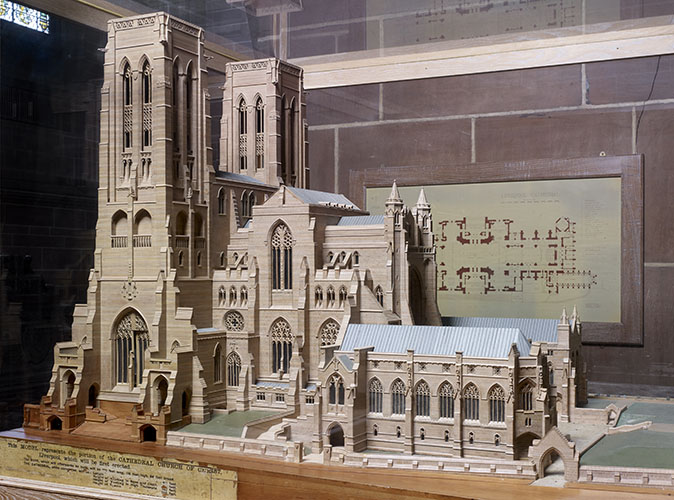
A design competition, won by William Emerson, came to nothing. Some felt his design for a Gothic building was insufficiently modern and failed to reflect either the city’s mercantile character or its predominantly Low-Church Anglicanism. More seriously, there was a clear desire for the new cathedral to be both very large and very prominent. In this regard, its proposed location on a site immediately behind St George’s Hall was problematic: it was expensive, constrained and threatened to create a ludicrous juxtaposition of Gothic and Classical design.
Exquisite houses, the beauty of Nature, and how to get the most from your life, straight to your inbox.
When Francis Chavasse succeeded to the bishopric in 1900, he immediately revived this failed project and appointed a committee to address the thorny issue of the cathedral site. It recommended St James’s Mount, an exhausted quarry and cemetery close to the city centre. The site was cheap and prominent, although its topography would necessitate skewing the orientation of a longitudinal church off a true East-West axis. The committee also had £125,000 at its disposal, the fruits of fundraising to date.
In reality, the public meeting addressed by Bishop Chavasse in June 1901 was actually a means of winning endorsement for a developed plan of action. In its aftermath, the terms of the project were enshrined in statute. The Liverpool Cathedral Act 1902 extended the terms of the 1885 Act, sanctioning the purchase of the new site and placing the project under the control of a building committee.

As the act was being prepared, work began to find a suitable architect in a two-round competition judged by two ‘assessors’, both doyens of the architectural world: Richard Norman Shaw and the Gothic Revival architect George Frederick Bodley.
There were numerous sensitivities to be dealt with in managing the competition. Norman Shaw insisted the clause demanding a ‘Gothic’ design be removed from the brief and the committee asked both assessors to not broach the subject of the building’s ‘non-orientation’ – advice they ignored. To the Bishop and building committee, the crucial point about the design was that ‘the central space at the crossing… should be large, and capable of seating 3,000 persons (without any interruption of the view from columns)’.
The two assessors inspected the anonymous designs of the five finalists at the Walker Art Gallery on May 4, 1903, and wrote a short report recommending ‘the set of drawings marked “No. 1”’. On examination, the committee was dismayed to discover that the architect, Giles Gilbert Scott, was only 22 years old, with no previous commissions to his name and a Roman Catholic. All that could be said in his favour was that he was a grandson of the great architect George Gilbert Scott.
The committee members also persuaded themselves that the central space of the proposed building could only seat 1,200 people. In letters dated May 15, the assessors were thanked for their involvement, but were informed that the commission could not go ahead. Then, the story leaked to the press.
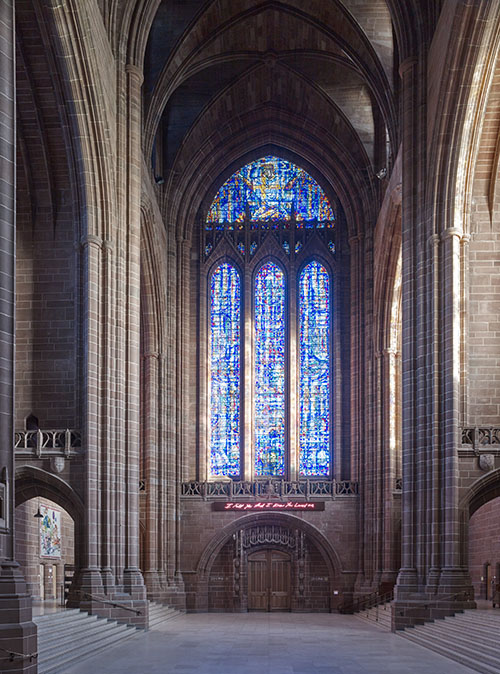
Norman Shaw wrote to the committee in baffled astonishment asserting that its seating calculations were wrong. Meanwhile, the committee tried, unsuccessfully, to persuade Bodley to take on the job. Eventually, high public feeling in Liverpool forced the committee to agree that Bodley and Scott should work together on the project.
The offer was wired to London by telegram on May 26 and both architects were agreeable, although Bodley’s desire to assume the role of ‘advisor’ was rejected. As the cathedral surveyor explained, only his involvement as ‘Joint Architect’ would satisfy public opinion.
Clearly, Bishop Chavasse was of the same mind. In a letter of congratulation to Bodley, he wrote: ‘With you at the helm I shall be certain that the best interests of the Church of England are duly safeguarded.’
He went on, however, to ask for reassurance that a Gothic cathedral would create a good auditorium for preaching, warning that a ‘cathedral in which few can hear would be an anachronism’.
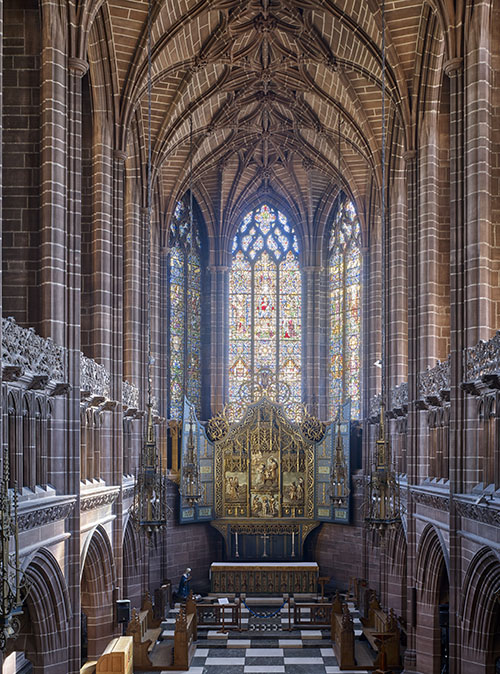
The young Scott and his opinions were not, apparently, given much thought at first.
The award of the commission precipitated a reappraisal of the design and the creation of a model of the east end to help fundraising. Consideration was given to the appropriate material for the new cathedral and, after lobbying and disagreement, a warm-red sandstone from the local quarry of Woolton was chosen. In the spring of 1904, as work to the east-end foundations got under way, gifts of farthings, halfpennies and pennies began to be raised for the foundation stone from Mother’s Meetings. The stone, the largest in the entire building, was laid later that year by Edward VII and Queen Alexandra on July 19, when a public holiday was declared.
It was quickly determined that one interior should be completed as fast as possible: the ‘Morning Chapel’, projecting from the east end. In obscure circumstances, this became the Lady Chapel and its foundations were complete in April 1906.
Preparing the plans for this building and its furnishings strained the relationship between the two architects. Scott complained that he undertook all the work and travel yet divided the architect’s income with his aged and ailing colleague. Bodley then rubbed salt in the wound by accepting two cathedral commissions in the USA in 1906.
These difficulties escalated into acrimony, but the two men made their peace before Bodley died in October 1907. He was not replaced and Scott took the opportunity to revise the designs for the Lady Chapel and, indeed, the entire building (which required some demolition work), proposing a central tower for the first time. This structure in turn underwent modifications when the choir and its transepts were consecrated in 1924. Scott was knighted during the celebrations.
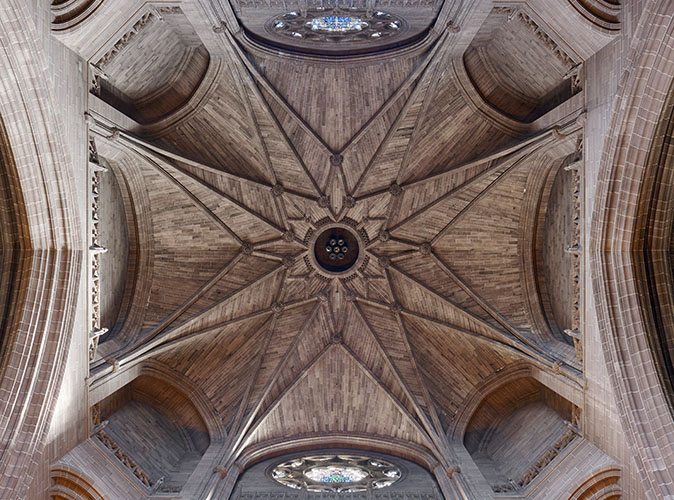
The central tower, which rises about 330ft high, was finished in 1942, followed by the first bay of the nave in 1961 (the year after Scott’s death). A former assistant, Roger Pinckney, simplified the final design of the nave and the whole building was brought to completion in 1978.
As constructed, the building takes the unusual form of a cross with four arms or transepts (also, felicitously, the device on the cathedral’s coat of arms, granted in 1931).
From the moment the visitor enters the church, it is possible to look through the whole length of the central vessel, the distant high altar framed beneath a great bridge of stone. The initial impression is simply of a vast recession of space majestic-ally articulated by flights of steps, monumental piers and gigantic vaults.
In fact, the interior is planned around a colossal octagonal vault – almost a dome – that rises beneath the central tower. This area, as Bishop Chavasse had hoped, is the focus of the building and borrows space from its four enclosing transepts.
To west and east, a nave and choir of three bays respectively bookend the composition. Scott ingeniously introduced liturgical divisions to this cavernous interior by means of changes in floor level: the aisles run without any interruption of steps through the full length of the building. In the nave, however, the floor of the main internal space drops down below aisle level and, in the choir, it rises up above it. Only in the central area are the aisles and central floors level.

The eye reads the monumental piers that rise up the interior as the essential supporting structural members of the building. Between them, great expanses of wall set off the stained-glass windows to spectacular effect. The treatment of the windows is inspired specifically by Chartres, which Scott visited on a trip to France in 1906.
Of the cathedral there, he wrote: ‘The enormous scale of the windows filling up the whole wall, and the huge lights, are the chief factors in producing the masculine grandeur. This character is my ideal and is what I want above everything [at Liverpool].’
However, Scott – in the manner of his grandfather – wanted the building to be a development of Gothic style in a modern idiom, rather than an archaeological exploration of any particular tradition. In technical terms, as a consequence, the design is remarkably eclectic, with references to German, Spanish and French design. Indeed, curiously, the only tradition arguably not clearly represented here is that of England.
No less remarkable than the architecture are the furnishings and fittings of the building, such as the sculpture by Edward Carter Preston, the magnificent organ (Fig 4) and the stained glass by many hands (some of it replaced after war damage). Its changing style is one of the few clues that the cathedral was built over many decades.
The unusual integration of memorials within the architecture is striking testimony to the degree to which those involved in the project felt possession of the building.
In the late 20th century, there were those who regarded Liverpool Cathedral as old-fashioned, an expiring gasp of the Gothic Revival, yet this assessment now, itself, seems dated. Admiration for Scott’s secular and industrial buildings, including, perhaps particularly, Bankside and Battersea Power Stations in London, reveals the extent to which he used the Gothic tradition – as explored in the development of this cathedral – as the basis for a modern architecture.
In this regard, he surely created a 20th-century building that ranks, in the words of Bishop Chavasse, amid ‘the great cathedrals which are amongst the greatest heritages of the English nation’.
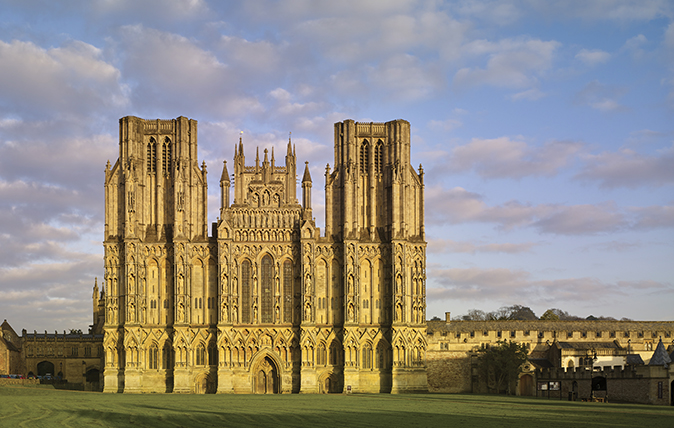
Wells Cathedral, Somerset: A symphony of architecture
In the first of two articles, John Goodall describes the architectural development of Wells and the struggle of its late-medieval

Pitshill House: A 20-year restoration that’s created one of the finest country seats in West Sussex
A major restoration project has brought 18th-century Pitshill House and its gardens to life. The work involved far more than
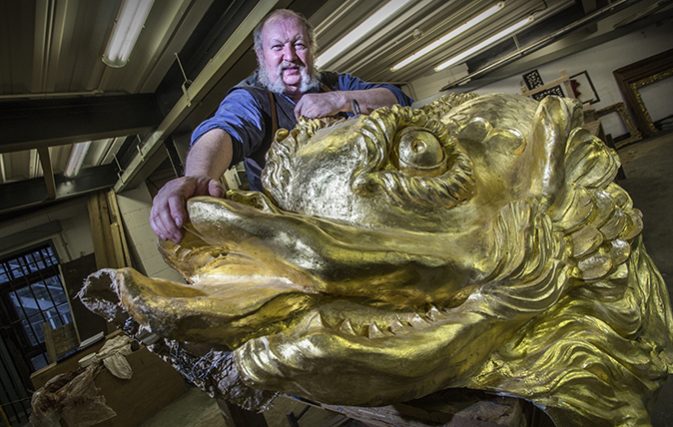
Six of Britain’s finest art and building conservationists on history, technology and the secrets of their trades
It takes a huge amount of skill and technical expertise to restore historic objects and interiors. John Goodall speaks to
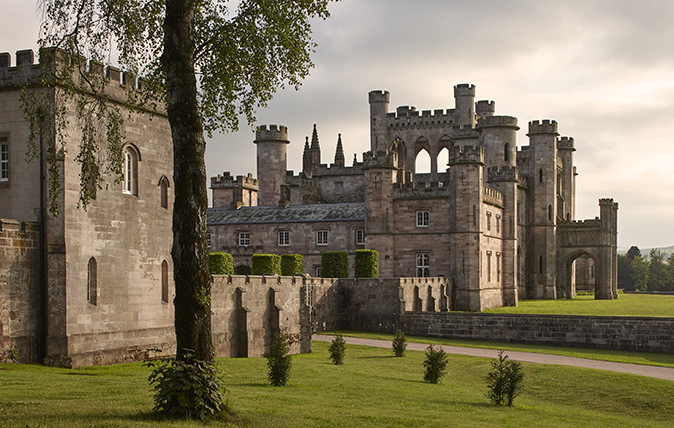
Lowther Castle: The incredible transformation of the ruins of one of Britain's greatest Regency castle
An ambitious restoration campaign has transformed the ruins of one of Britain’s greatest Regency castles and brought it back to

John spent his childhood in Kenya, Germany, India and Yorkshire before joining Country Life in 2007, via the University of Durham. Known for his irrepressible love of castles and the Frozen soundtrack, and a laugh that lights up the lives of those around him, John also moonlights as a walking encyclopedia and is the author of several books.